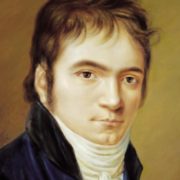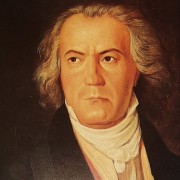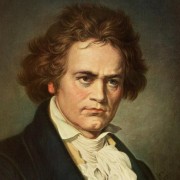Ludwig van Beethoven
Learn about one of the greatest classical composers and view videos with his best music being performed by the very best orchestras and soloists.
–
Quotes by Beethoven
Only art and science can raise men to the level of gods.
–
Music is the wine that inspires one to new generative processes, and I am Bacchus who presses out this glorious wine for mankind and makes them spiritually drunken.
–
Recommend virtue to your children; it alone, not money, can make them happy. I speak from experience.
–
Music is a higher revelation than all wisdom and philosophy. Music is the electrical soil in which the spirit lives, thinks and invents.
–
Music should strike fire from the heart of man, and bring tears from the eyes of a woman.
–
Music is the mediator between the spiritual and the sensual life.
–
There is nothing more beautiful than distributing happiness to many people.
–
I wish you music to help with the burdens of life and to help you release your happiness to others.
–
Then let us all do what is right, strive with all our might toward the unattainable, develop as fully as we can the gifts God has given us, and never stop learning.
–
I have never thought of writing for reputation and honor. What I have in my heart must come out; that is the reason why I compose.
–
The vibrations in the air are the breath of God speaking to man’s soul. Music is the language of God. We musicians are as close to God as a man can be. We hear his voice, we read his lips, we give birth to the children of God, who sing his praise. That’s what musicians are.
–
Biography
 Ludwig van Beethoven (17 December 1770 – 26 March 1827) was a German composer and pianist. A crucial figure in the transition between the Classical and Romantic eras in Western art music, he remains one of the most famous and influential of all composers. His best-known compositions include 9 symphonies, 5 concertos for piano, a violin concerto, 32 piano sonatas, and 16 string quartets. He also composed other chamber music, choral works and songs.
Ludwig van Beethoven (17 December 1770 – 26 March 1827) was a German composer and pianist. A crucial figure in the transition between the Classical and Romantic eras in Western art music, he remains one of the most famous and influential of all composers. His best-known compositions include 9 symphonies, 5 concertos for piano, a violin concerto, 32 piano sonatas, and 16 string quartets. He also composed other chamber music, choral works and songs.
 Beethoven was the second-oldest child of the court musician and tenor singer Johann van Beethoven in Bonn. Ludwig’s father had the ambition of showcasing his son as a child prodigy. Ludwig gave his first public performance as a pianist when he was eight years old. At the age of eleven, he received the necessary systematic training in piano performance and composition from Christian Gottlob Neefe, organist and court musician in Bonn. Employed as a musician in the Bonn court orchestra since 1787, Beethoven was granted a paid leave of absence in the early part of 1787 to study in Vienna under Mozart, but he was soon compelled to return to Bonn, and after his mother’s death he had to look after the family.
Beethoven was the second-oldest child of the court musician and tenor singer Johann van Beethoven in Bonn. Ludwig’s father had the ambition of showcasing his son as a child prodigy. Ludwig gave his first public performance as a pianist when he was eight years old. At the age of eleven, he received the necessary systematic training in piano performance and composition from Christian Gottlob Neefe, organist and court musician in Bonn. Employed as a musician in the Bonn court orchestra since 1787, Beethoven was granted a paid leave of absence in the early part of 1787 to study in Vienna under Mozart, but he was soon compelled to return to Bonn, and after his mother’s death he had to look after the family.
 However, in 1792 he chose Vienna as his new residence taking lessons from Haydn and Salieri. By 1795 he had earned a name for himself as a pianist of great fantasy, admired in particular for his brilliant improvisations. Before long he was traveling in the circles of the nobility. They offered Beethoven their patronage, and the composer dedicated his works to them in return. By 1809 his patrons provided him with an annuity that enabled him to live as a freelance composer without financial worries. Beethoven was acutely interested in the development of the piano. He kept close contact with the leading piano building firms in Vienna and London and thus helped pave the way for the modern concert grand piano.
However, in 1792 he chose Vienna as his new residence taking lessons from Haydn and Salieri. By 1795 he had earned a name for himself as a pianist of great fantasy, admired in particular for his brilliant improvisations. Before long he was traveling in the circles of the nobility. They offered Beethoven their patronage, and the composer dedicated his works to them in return. By 1809 his patrons provided him with an annuity that enabled him to live as a freelance composer without financial worries. Beethoven was acutely interested in the development of the piano. He kept close contact with the leading piano building firms in Vienna and London and thus helped pave the way for the modern concert grand piano.
Around the year 1798, Beethoven noticed that he was suffering from a hearing disorder. He withdrew into increasing seclusion from the public and from his few friends and was eventually completely deaf. By 1820 he was able to communicate with visitors and trusted friends only in writing, availing himself of “conversation notebooks”. In 1811 he gave up conducting and performing in public but continued to compose; many of his most admired works come from these last 15 years of his life.
The final years in the life of the restless bachelor were darkened by severe illness and by the struggle over the guardianship of his nephew Karl, upon whom he poured his solicitude, jealousy, expectations, and threats in an effort to shape the boy according to his wishes. When the most famous composer of the age died, about thirty thousand mourners and curious onlookers were present at the funeral procession on March 26, 1827.
–
Piano Concerto No. 1 in C major, Op. 15
This was written between 1796 and 1797. Dedicated to his pupil Countess of Bratislava, Anna Louise Barbara (“Babette”) Keglevics, its first performance was in Prague in 1798, with Beethoven himself playing the piano.
There are three movements
Allegro con brio
Largo
Rondo. Allegro scherzando
In the video, the concerto is performed by Murray Perahia, and the London Symphony Orchestra is conducted by Georg Solti.
This is a fine video with the concerto being played by Krystian Zimerman and the Vienna Philharmonic Orchestra.
–
Piano concerto no. 2 in b-flat major, op. 19
This concerto was composed primarily between 1787 and 1789, although it did not attain the form it was published until 1795. The concerto became an important display piece for the young Beethoven as he sought to establish himself after moving from bonn to Vienna. He was the soloist at its premiere on 29 march 1795, at Vienna’s Burgtheater in a concert marking his public debut.
The concerto is in three movements:
Allegro con brio
Adagio
Rondo Molto allegro
Here is a fine video with the concerto being played by Krystian Zimerman and the Vienna Philharmonic Orchestra.
–
Piano concerto no. 3 in c minor, op. 37
This was composed in 1800 and was first performed on 5 april 1803, with the composer as soloist. The composition was dedicated to prince Louis Ferdinand of Prussia. The first primary theme is reminiscent of that of Mozart’s 24th piano concerto.
The work is in three movements:
1 Allegro con brio (1:04)
2 Largo (17:59)
3 Rondo. Allegro (27:25)
In the video, the concerto is performed by Alfred Brendel and the Lucerne Festival Orchestra conducted by Claudio Abbado.
In this older video, the concerto is performed by the legendary pianist Arthur Rubinstein and the Concertgebouw Orchestra conducted by Bernard Haitink. The concert took place on 31 August 1973.
–
Piano concerto no. 4 in g major, op. 58
This concert was composed in 1805–1806 and has three movements:
Allegro moderato
Andante con moto
Rondo (Vivace)
The first public performance was on 22 December 1808 in Vienna at the Theater an der Wien. This was part of a marathon concert that saw Beethoven’s last appearance as a soloist with orchestra, as well as the premieres of the Choral Fantasy and the Fifth and Sixth symphonies;
In the video, the concert is played by pianist Nino Gvetadze with the Georgian Sinfonietta conducted by Markus Poschner.
Here is another video where the concert is performed by the legendary pianist Claudio Arrau and the Bavarian Broadcast Symphony Orchestra conducted by Leonard Bernstein.
Here is an older video where the concerto is performed by the legendary Wilhelm Backhaus and the Wiener Symphoniker conducted by Karl Böhm.
Finally, a newer video showing a performance of the concerto by Mitsuko Uchida and the Bavarian Radio Symphony Orchestra conducted by Mariss Jansons.
–
Piano concerto no. 5 in e-flat major, op. 7
This is popularly known as the emperor concerto and was the last piano concerto of Beethoven. It was written between 1809 and 1811 in Vienna. The first performance took place on 28 November 1811 at the Gewandhaus in Leipzig. The concerto is divided into three movements:
Allegro in E-flat major
Adagio un poco mosso in B major
Rondo: Allegro ma non troppo in E-flat major
Here is another fine video where the concerto is performed by Alina Bercu and the Orchestra of the University of Music Franz Liszt in Weimar conducted by Nicolás Pasquet.
In this video, the concerto is performed by Krystian Zimerman and the Vienna Philharmonic Orchestra conducted by Leonard Bernstein.
–
Symphony No. 1 in C major, Op. 21
This symphony is clearly indebted to Beethoven’s predecessors, particularly his teacher Joseph Haydn as well as Wolfgang Amadeus Mozart, but nonetheless has characteristics that mark it uniquely as Beethoven’s work, notably the frequent use of sforzandi and the prominent, more independent use of wind instruments. The premiere took place on 2 April 1800 at the K.K. Hoftheater nächst der Burg in Vienna. This concert effectively served to announce Beethoven’s talents to Vienna.
There are 4 movements:
1. Adagio molto – Allegro con brio
2. Andante cantabile con moto
3. Menuetto: Allegro molto e vivace
4. Adagio – Allegro molto e vivace
In this video, the symphony is performed by Deutsche Kammerphilharmonie Bremen conducted by Paavo Järvi.
Finally, this video shows a performance of the symphony by the Karajan Academy of the Berliner Philharmoniker conducted by Cornelius Meister. The concert took place at the Chamber Music Hall of the Berlin Philharmonie, on 9 November 2019.
–
Symphony No. 2 in D major, Op. 36
This symphony was mostly written during Beethoven’s stay at Heiligenstadt in 1802, at a time when his deafness was becoming more pronounced and he began to realize that it might be incurable. The work was premiered in the Theater an der Wien in Vienna on 5 April 1803 and was conducted by the composer.
This symphony consists of four movements:
I. Adagio molto – Allegro con brio (0:01)
II. Larghetto (11:40)
III. Scherzo: Allegro (21:47)
IV. Allegro molto (25:43)
In the video, the symphony is performed by Deutsche Kammerphilharmonie Bremen conducted by Paavo Järvi.
Here is a video showing the performance in the Royal Albert Hall, on 20 July 2012 of the symphony by the West-Eastern Divan Orchestra conducted by Daniel Barenboim.
Finally, this video shows a performance of the symphony by the Frankfurt Radio Symphony Orchestra conducted by Andrés Orozco-Estrada. The concert took place at the Alte Oper in Frankfurt, 15. April 2016.
–
Symphony No. 3 in E-flat major, Opus 55
This symphony (also named Eroica – the Heroic Symphony) is a structurally rigorous composition of great emotional depth, which marked the beginning of the creative middle period of Beethoven.
Beethoven began composing the third symphony soon after Symphony No. 2 in D major, Opus 36; he completed the composition in early 1804, and the first public performance of Symphony No. 3 was on 7 April 1805 in Vienna.
The work is in four movements:
Allegro con brio
Marcia funebre: Adagio assai in C minor
Scherzo: Allegro vivaceFinale: Allegro molto
In this video, the symphony is performed by the Orchestre national de France conducted by the legendary Bernard Haitink.
d by-
Symphony No. 4 in B flat major, Op. 60
This symphony was composed in the summer of 1806 and premièred in March 1807 at a private concert at the home of Prince Franz Joseph von Lobkowitz.
The work was dedicated to Count Franz von Oppersdorff who listened to Beethoven’s Symphony No. 2 and liked it so much that he offered a great amount of money for Beethoven to compose a new symphony for him.
The work is in four movements:
i. Adagio — Allegro vivace
ii. Adagio
iii. Allegro vivace
iv. Allegro ma non troppo
In the video, the symphony is performed by Frankfurt Radio Symphony Orchestra conducted by Andrés Orozco-Estrada. The concerto took place in Alte Oper in Frankfurt, on 12th February 2016.
In the video presented here the symphony is performed by the Royal Concertgebouw Orchestra conducted by Iván Fischer.
Finally, this older video shows a performance of the symphony by the Concertgebouw Orchestra in Amsterdam conducted by the phenomenal German-born Austrian conductor Carlos KLeiber.
–
Symphony No. 5 in C minor, Op. 67
This was written between 1804 and 1808. It is one of the best-known compositions in classical music, and one of the most frequently played symphonies. It was premiered on 22 December 1808 at a mammoth concert at the Theater an der Wien in Vienna consisting entirely of Beethoven premieres, and directed by Beethoven himself on the conductor’s podium.The work achieved its prodigious reputation soon afterward and was described as “one of the most important works of the time”.
There are four Movements:
1. Allegro con brio- [00:01]
2. Andante con moto- [07:33]
3. Allegro- [18:17]
4. Allegro- [23:17]
In this video, the symphony is performed by the Royal Concertgebouw Orchestra conducted by Iván Fischer.
Finally, in this video, the symphony is performed by the Símon Bolívar Symphony Orchestra of Venezuela conducted by Gustavo Dudamel.
–
Symphony No. 6 in F major, Op. 68
This is also known as the Pastoral Symphony. It was completed in 1808. The symphony has five movements, rather than the four being typical of symphonies of the Classical era. Beethoven annotated the beginning of each movement as follows:
Awakening of cheerful feelings upon arrival in the countryside: Allegro ma non troppo
Scene by the brook: Andante molto mosso
Merry gathering of country folk: Allegro
Thunder. Storm: Allegro
Shepherd’s song; cheerful and thankful feelings after the storm: Allegretto
In the video, the symphony is performed by the Eastern Divan Orchestra conducted by Daniel Barenboim.
In this video, the symphony is performed by Sinfonia Rotterdam conducted by Conrad van Alphen. The concert took place in the Basilica of Saint-Willibrordus in Hulst on 14 October 2017.
–
Symphony No. 7 in A major, Op. 92
This symphony in four movements was composed by Ludwig van Beethoven between 1811 and 1812 while improving his health in the Bohemian spa town of Teplice.
The Seventh Symphony is in four movements:
Poco sostenuto – Vivace
Allegretto
Presto – Assai meno presto (trio)
Allegro con brio
In the video, the symphony is performed by the Royal Concertgebouw Orchestra conducted by Iván Fischer.
Finally, in this older video, the symphony is performed by the Concertgebouw Orchestra conducted by the legendary Carlos Kleiber.
–
Symphony No. 8 in F Major, Op. 93
This symphony Beethoven fondly referred to it as “my little Symphony in F,” distinguishing it from his Sixth Symphony, a longer work also in F.
The Eighth Symphony is generally light-hearted, though not lightweight. The symphony deviates from Classical tradition in making the last movement the weightiest of the four.
The four movements are:
1. Allegro vivace e con brio (F major) 00:00
2. Allegretto scherzando (B♭ major) 10:26
3. Tempo di menuetto (F major) 15:06
4. Allegro vivace (F major) 20:30
In the video, the symphony is performed by Netherlands Chamber Orchestra with Gordan Nikolić as the concertmaster. Recorded live on January 15 2018 at the Concertgebouw in Amsterdam.
Finally, this video presents a performance by Deutsche Kammerphilharmonie Bremen conducted by Paavo Järvi.
–
Symphony No. 9 in A major “the Choral”, Op. 125
This is Beethoven’s last symphony from 1824. It was the first time a major composer used voices in a symphony. The words are sung during the final movement by four vocal soloists and a chorus. They were taken from the “Ode to Joy”, a poem written by Friedrich Schiller in 1785 and revised in 1803, with additions made by the composer. Today, it stands as one of the most played symphonies in the world.
The symphony is in four movements, marked as follows:
I. Allegro ma non troppo, un poco maestoso
II. Scherzo: Molto vivace – Presto
III. Adagio molto e cantabile
IV. Presto; Allegro molto assai (Alla marcia); Andante maestoso; Allegro energico, sempre ben marcato
In this video, the symphony is performed by the Chicago Symphony Orchestra and Chorus conducted by Riccardo Muti.
Here is a video showing a performance of the symphony by the Oslo Philharmonic Orchestra conducted by Klaus Mäkelä.
–
Violin Concerto in D major, Op. 61
The violin concerto was written in 1806. Its first performance by Franz Clement was unsuccessful and for some decades the work languished in obscurity until revived in 1844 by Joseph Joachim. Since then it has become one of the most well-known violin concerti.
The work is in three movements:
Allegro ma non troppo (D major)
Larghetto (G major)
Rondo. Allegro (D major)
Here is a fine video where the concerto is performed by the very fine violinist Hilary Hahn and the Detroit Symphony Orchestra conducted by Leonard Slatkin. As an encore, the soloist plays the gigue from the third Partita by J.S. Bach.
Here is another fine older video where the concerto is performed by a very young Anne-Sophie Mutter and the Berlin Philharmonic Orchestra conducted by Herbert von Karajan.
In this video, the violin concerto is performed by violinist Joshua Bell.


